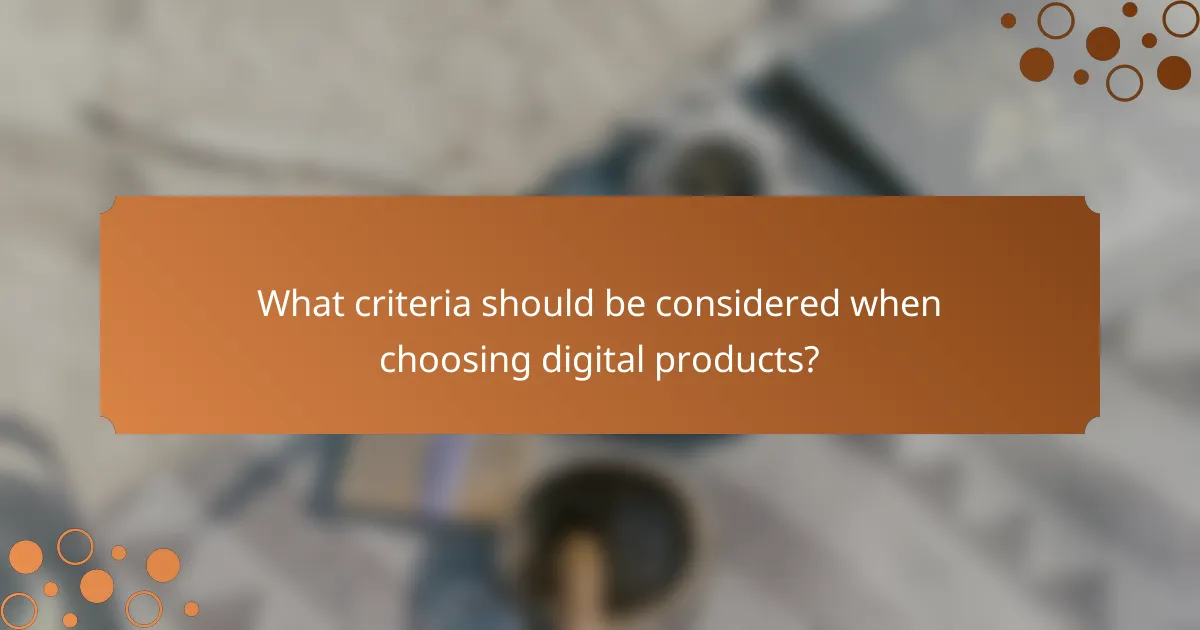Digital products encompass a variety of offerings, including software solutions, media content, mobile applications, and educational resources, each designed to meet specific user needs. These products differ across industries in terms of functionality and target audience, influencing their design and delivery. With applications ranging from business operations to customer engagement, digital products play a crucial role in enhancing efficiency and interaction in today’s economy.

What are the key digital products in the market?
Key digital products include software solutions, media content, mobile applications, educational resources, and subscription services. Each category serves distinct user needs and operates under various business models, making them essential in today’s digital economy.
Software as a Service (SaaS)
Software as a Service (SaaS) refers to cloud-based applications that users access via the internet, eliminating the need for local installation. Common examples include platforms like Salesforce, Google Workspace, and Microsoft 365, which offer subscription-based access to software tools.
When considering SaaS, evaluate factors such as scalability, security, and integration capabilities. Many SaaS solutions operate on a tiered pricing model, allowing businesses to choose plans that fit their size and usage needs.
Digital Media Products
Digital media products encompass a wide range of content, including music, videos, and images, typically delivered through streaming services or downloads. Platforms like Spotify and Netflix exemplify this model, providing users with access to vast libraries of content for a monthly fee.
For creators, understanding copyright and licensing is crucial when distributing digital media. Additionally, consider the impact of user engagement metrics on content visibility and revenue generation.
Mobile Applications
Mobile applications are software designed specifically for smartphones and tablets, available through app stores like Apple’s App Store and Google Play. They can serve various purposes, from productivity tools to games, and often utilize in-app purchases or ads for monetization.
When developing a mobile app, focus on user experience and performance optimization. Regular updates and user feedback are essential for maintaining engagement and addressing technical issues.
E-books and Online Courses
E-books and online courses provide educational content in digital formats, allowing users to learn at their own pace. Platforms like Amazon Kindle for e-books and Coursera for online courses have made it easier for consumers to access a wealth of knowledge.
When creating or purchasing e-books and courses, consider the credibility of the source and the depth of content provided. Engaging multimedia elements can enhance learning experiences and retention.
Subscription Services
Subscription services offer users access to a variety of products or services for a recurring fee, ranging from physical goods to digital content. Examples include meal kit deliveries, streaming services, and software subscriptions.
When evaluating subscription services, assess the value offered versus the cost. Look for flexible plans that allow for easy cancellation or modification to avoid long-term commitments that may not meet your needs.

How do digital products differ across industries?
Digital products vary significantly across industries based on their functionality, target audience, and regulatory requirements. Each sector utilizes digital solutions tailored to its specific needs, which influences design, delivery, and user experience.
Technology Industry
The technology industry focuses on software applications, platforms, and tools that enhance productivity and innovation. Common digital products include mobile apps, cloud services, and enterprise software solutions. Companies often prioritize user experience and scalability to meet the demands of a rapidly evolving market.
For example, a project management tool may offer features like task tracking, collaboration, and integration with other software. When developing tech products, consider factors such as security standards and user feedback to ensure relevance and effectiveness.
Education Sector
In the education sector, digital products encompass e-learning platforms, educational software, and virtual classrooms. These products aim to facilitate learning and improve accessibility for students of all ages. Features often include interactive content, assessment tools, and progress tracking.
For instance, a learning management system (LMS) might provide course materials, quizzes, and forums for student interaction. When creating educational digital products, focus on usability and alignment with curriculum standards to enhance learning outcomes.
Entertainment Industry
The entertainment industry leverages digital products such as streaming services, video games, and digital media platforms to engage audiences. These products are designed for user enjoyment and often incorporate social features to enhance interaction among users.
Streaming platforms like Netflix or Spotify offer vast libraries of content that cater to diverse tastes. When developing entertainment products, prioritize content quality and user engagement strategies to retain subscribers and attract new users.
Healthcare Applications
Digital products in healthcare include telemedicine platforms, health management apps, and electronic health records (EHR) systems. These products aim to improve patient care, streamline operations, and ensure compliance with healthcare regulations. Security and privacy are critical considerations due to sensitive patient data.
For example, a telehealth app might allow patients to consult with doctors remotely, providing convenience and access to care. When designing healthcare applications, adhere to regulations like HIPAA in the U.S. to protect patient information and enhance trust in your product.

What are the applications of digital products?
Digital products have a wide range of applications across various industries, enhancing efficiency and engagement. They are utilized in business operations, marketing strategies, customer engagement, and remote learning, each serving distinct purposes and offering unique benefits.
Business Operations
In business operations, digital products streamline processes and improve productivity. Tools such as project management software, cloud storage, and automated workflows enable teams to collaborate effectively, reducing time spent on manual tasks.
For example, platforms like Asana or Trello help manage projects by allowing teams to track progress and deadlines in real-time. This can lead to a more organized work environment and ultimately increase overall efficiency.
Marketing Strategies
Digital products play a crucial role in modern marketing strategies by providing data-driven insights and targeted outreach. Tools like email marketing software and social media analytics allow businesses to reach specific audiences and measure campaign effectiveness.
Utilizing platforms such as Mailchimp or Hootsuite can enhance marketing efforts by automating communications and analyzing customer engagement metrics. This helps businesses refine their strategies based on real-time feedback.
Customer Engagement
Customer engagement is significantly enhanced through digital products, which facilitate direct interaction and feedback. Applications like chatbots, mobile apps, and customer relationship management (CRM) systems enable businesses to connect with customers more effectively.
For instance, using a CRM like Salesforce can help track customer interactions and preferences, allowing for personalized communication. This fosters loyalty and improves customer satisfaction.
Remote Learning
Remote learning has been transformed by digital products, providing flexible access to educational resources. Platforms such as online course providers and virtual classrooms enable learners to engage with content from anywhere.
Tools like Zoom or Google Classroom facilitate real-time interaction between instructors and students, making education more accessible. This flexibility allows for a diverse range of learning styles and schedules, catering to various needs.

What criteria should be considered when choosing digital products?
When selecting digital products, consider factors such as target audience needs, cost and pricing models, and the product’s usability. These criteria help ensure that the digital product effectively meets user expectations and provides value.
Target Audience Needs
Understanding the needs of your target audience is crucial when choosing digital products. Conducting market research can reveal preferences, pain points, and desired features that resonate with users. Tailoring the product to address these specific needs increases the likelihood of user adoption and satisfaction.
For example, if your audience consists of small business owners, a digital product that simplifies accounting or project management may be highly appealing. Always prioritize user feedback during the development process to refine the product further.
Cost and Pricing Models
Cost is a significant factor in selecting digital products, both for the developer and the end user. Evaluate various pricing models, such as subscription-based, one-time purchase, or freemium options, to determine which aligns best with your target audience’s willingness to pay.
For instance, subscription models can provide a steady revenue stream and allow users to access updates and support continuously. However, ensure that the pricing reflects the value offered; overly high prices may deter potential customers, while too low prices might undermine perceived quality.
